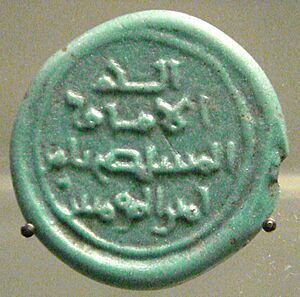Al-Mustadi facts for kids
Quick facts for kids al-Hassan al-Mustadiالحسن المستضيء بأمر الله |
|||||
|---|---|---|---|---|---|
| Khalīfah Amir al-Mu'minin |
|||||

Turquoise glass stamp of al-Mustadi
|
|||||
| 33rd Caliph of the Abbasid Caliphate Abbasid Caliph in Baghdad |
|||||
| Reign | 18 December 1170 – 27 March 1180 | ||||
| Predecessor | al-Mustanjid | ||||
| Successor | al-Nasir | ||||
| Born | 1142 Baghdad, Abbasid Caliphate |
||||
| Died | 27 March 1180 (aged 38) Baghdad, Abbasid Caliphate |
||||
| Consort | Zumurrud Khatun Sayyida Banafsha Sharaf Khatun Khtalj Khatun al-Abbasah |
||||
| Issue | Al-Nasir Abu Mansur Hashim |
||||
|
|||||
| Dynasty | Abbasid | ||||
| Father | al-Mustanjid | ||||
| Mother | Ghaddha | ||||
| Religion | Sunni Islam | ||||
al-Mustadi (born Hasan ibn Yusuf al-Mustanjid; 1142 – 27 March 1180) was a very important ruler called a Caliph. He was part of the Abbasid family. He ruled in Baghdad from 1170 to 1180. He became Caliph after his father, al-Mustanjid, passed away.
Contents
Who Was Al-Mustadi?
Al-Mustadi was born in 1142. His father was Caliph al-Mustanjid. His mother was Ghaddha, who was from Armenia. His full name was Hasan ibn Yusuf al-Mustanjid. He was named after an earlier Caliph, al-Hasan. When his father died in December 1170, al-Mustadi became the new Caliph.
Building Projects in Baghdad
Al-Mustadi's time as Caliph was known for a lot of building work. He had the al-Taj palace in Baghdad rebuilt. This palace was first built hundreds of years before. Many new mosques, schools, and religious buildings were also constructed. His two wives, Sayyida Banafsha and Zumurrud Khatun, helped a lot with these projects. Banafsha, who followed a certain Islamic teaching called Hanbali, even had a bridge built in Baghdad. It was named after her.
Caliph's Power and Saladin
During al-Mustadi's rule, the Caliph had some independence. He had his own advisors and a small army. This army was enough for small local battles. A very famous leader named Saladin was active during this time. Saladin ended the Shia Fatimid Caliphate in Egypt. This was a rival group of rulers. Saladin then became the Sultan of Egypt. He declared his loyalty to the Abbasid Caliphs, like al-Mustadi. This meant he recognized al-Mustadi as the main leader of the Muslim world.

Saladin's Rise in Egypt
Towards the end of 1169, Saladin won a big battle near Damietta. He defeated an army of Crusaders and Byzantines. Later, in 1170, Saladin's father came to Egypt. This happened because Caliph al-Mustanjid (al-Mustadi's father) wanted Saladin to remove the rival Caliph, al-Adid, in Egypt. Saladin was making his power stronger in Egypt. He gave important jobs to his family members. He also built colleges for different branches of Sunni Islam in Egypt.
Saladin also fought against the Crusaders. He attacked a Crusader castle called Eilat. This castle was on an island. It wasn't a big threat to the Muslim navy. But Saladin wanted to make sure it was not in his way.
Abbasid Rule Returns to Egypt
In 1171, Saladin was asked to bring back the Abbasid Caliphate in Egypt. This was a big deal because Egypt had been ruled by the Fatimids for a long time. Saladin agreed. The Fatimid Caliph al-Adid became ill and died. After his death, the Abbasid Caliph, al-Mustadi, was officially recognized as the Caliph in Egypt. This happened in Cairo and al-Fustat.
Important Scholars
During al-Mustadi's time, a scholar named Ibn al-Jawzi became very famous in Baghdad. Al-Mustadi liked the Hanbali school of thought. So, he let Ibn al-Jawzi preach and teach about it all over Baghdad. Ibn al-Jawzi gave many speeches. People loved his speaking skills. Caliph al-Mustadi even had a special platform built for him in the Palace mosque. Ibn al-Jawzi became one of the most respected scholars of his time.
By 1179, Ibn al-Jawzi had written over 150 books. He was also in charge of five colleges in Baghdad. He asked al-Mustadi to put a special message on the tomb of Ibn Hanbal. Ibn Hanbal was the founder of the Hanbali teachings. The message called him "Imam," which means a great leader.
Baghdad as a Great City
A traveler named Benjamin of Tudela visited Baghdad between 1160 and 1173. He wrote about the city and the Caliph. He said Baghdad was a huge city. The Caliph's palace was very big, about three miles long. It had a large park with many trees and animals. There was also a pond filled with water from the Tigris river. The Caliph would invite his friends to the palace to enjoy themselves. Benjamin also noted that the Caliph was friendly to Jewish people. Many of his officers were Jewish. The Caliph knew many languages, including Hebrew. He also made his own money by making things with his hands, like blankets.
In 1180, Caliph al-Mustadi died. His son, Al-Nasir, became the next Caliph.
Family
Al-Mustadi had several wives and concubines. One of them was Zumurrud Khatun. She was from Turkey. She was the mother of Al-Nasir, who would become the next Caliph. She passed away around 1202 or 1203. She was buried in her own special tomb.
Another important concubine was Al-Sayyida Banafsha. She was from Greece and was al-Mustadi's favorite. She died in 1201 and was buried near Zumurrud Khatun. Sharaf Khatun was another concubine from Turkey. She was the mother of Prince Abu Mansur Hashim. She died in 1211. Al-Mustadi also had other concubines named Khtalj Khatun and al-Abbasah, both from Turkey.
See also
- Ibn al-Jawzi was an Arab Muslim jurisconsult, preacher, orator, heresiographer, traditionist, historian, judge, hagiographer, and philologist.

